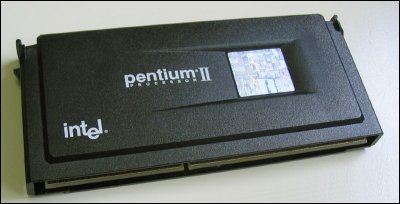The Pentium II’s Single Edge Contact cartridge technology allows the core and L2 cache to be fully enclosed in a plastic and metal cartridge. These sub-components are surface mounted directly to a substrate inside the cartridge to enable high-frequency operation. The cartridge allows the use of widely available, high-performance industry Burst SRAMs for the dedicated L2 cache, enabling high-performance processing at mainstream price points.

There are six individually packaged devices on the SEC cartridge substrate: the processor, four industry-standard burst-static-cache RAMs and one tag RAM. The SEC cartridge confers important design advantages. The Pentium Pro’s PGA package required 387 pins, while the SEC cartridge uses only 242. This one-third reduction in the pin count is due to the fact that the SEC cartridge contains discrete components, such as termination resistors and capacitors. These items provide signal decoupling, which means that far fewer power pins are required. The slot the SEC cartridge uses is called Slot 1 and can be seen as taking over where the previous Socket 7 processor mount left off.
- Pentium Architecture
- Pentium Pro
- Pentium MMX Technology
- Pentium II
- Pentium SEC
- Pentium “Deschutes
- Pentium Xeon
- Pentium III
- Pentium Tualatin
- Pentium 4
- Pentium Northwood
- Hyper-Threading Technology
- Pentium Prescott
- Pentium Processor Numbers
- Multi-Core Processors
- Pentium Smithfield
- Pentium D
- Pentium Roadmap